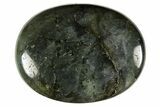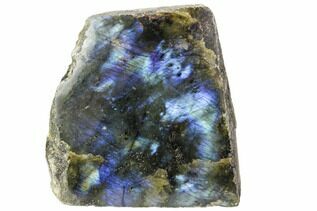1.7" Polished Labradorite Pocket Stones
These are 1.7" wide, polished labradorite pocket stones. The photos are representative of the specimen(s) you will receive, so there may be some variation in labradorescene and patterns from specimen to specimen. Quantity discounts are available!
The stone is polished into an oval shape and rounded on all sides. Polished stones of this size and shape are generally referred to as pocket stones since they will easily fit into a pocket. The pictures are representative of the stone you will receive, but there will be some variation in colors and patterning.
About Labradorite
Labradorite is a feldspar mineral most often found in mafic igneous rocks. Some specimens of labradorite exhibit what is called a "Schiller effect"; a strong play of iridescent blue, green, red, orange, and yellow colors. Labradorite is so well known for these spectacular displays of color that the phenomenon is also known as labradorescence. Specimens with high quality labradorescence are often polished and used as gemstones.
The labradorescence is not caused by the colors breflecting on the surface of the specimen. Instead, light enters the stone, hits a twinning crystal lattice surface within the stone, and reflects from that. The color seen is the color of light reflected from that twinning surface. Different twinning surfaces within the stone reflect different colors of light. Light reflecting from different twinning surfaces in various parts of the stone can give the stone a multi-colored appearance.
Labradorite is named after Labrador, Canada, where it was first found. Today, the most prolific deposits for most commercially available labradorite occur in Madagascar and Russia.
Labradorite is a feldspar mineral most often found in mafic igneous rocks. Some specimens of labradorite exhibit what is called a "Schiller effect"; a strong play of iridescent blue, green, red, orange, and yellow colors. Labradorite is so well known for these spectacular displays of color that the phenomenon is also known as labradorescence. Specimens with high quality labradorescence are often polished and used as gemstones.
The labradorescence is not caused by the colors breflecting on the surface of the specimen. Instead, light enters the stone, hits a twinning crystal lattice surface within the stone, and reflects from that. The color seen is the color of light reflected from that twinning surface. Different twinning surfaces within the stone reflect different colors of light. Light reflecting from different twinning surfaces in various parts of the stone can give the stone a multi-colored appearance.
Labradorite is named after Labrador, Canada, where it was first found. Today, the most prolific deposits for most commercially available labradorite occur in Madagascar and Russia.
$6
Quantity Discounts
3 to 9 Pieces
$5
10+ Pieces
$4
TYPE
Polished Labradorite Pocket Stone
SPECIES
Labradorite (Plagioclase Feldspar)
LOCATION
Maniry, Madagascar
SIZE
Approximately 1.7 x 1.4 x .6"
PRODUCT ID
P-835
 Reviews
Reviews













